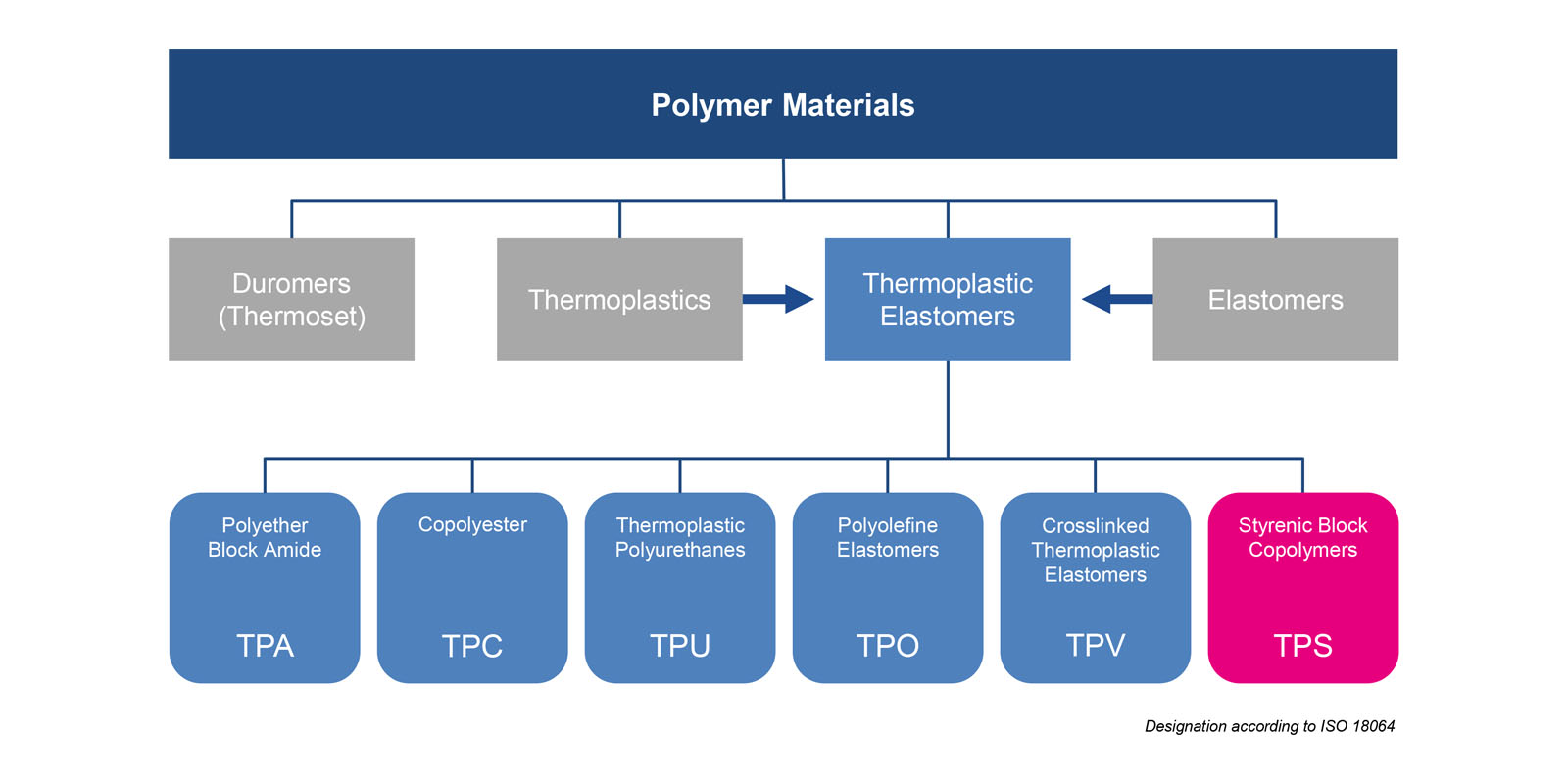Resumen de los hechos más importantes
- Los productos TPS consisten en al menos un copolímero tribloque de estireno y un dieno específico en el que los dos segmentos extremos son poliestireno y el segmento blando interior es un polidieno o un polidieno hidrogenado.
- Los TPS son compuestos, lo que significa que los fabricantes funden y homogeneizan diversas materias primas en sistemas de extrusión.
- Sin embargo, los elastómeros termoplásticos también pueden moldearse por soplado o procesarse mediante impresión 3D.
- Debido a su reticulación física, los elastómeros termoplásticos siempre se pueden fundir y devolver a la cadena de procesamiento.
¿Qué significa TPS?
Los copolímeros de bloques de estireno termoplásticos, o TPS, describen un subgrupo de elastómeros termoplásticos (TPE).
Los productos TPS consisten en al menos un copolímero tribloque de estireno y un dieno específico en el que los dos segmentos extremos son poliestireno y el segmento blando interior es un polidieno o un polidieno hidrogenado.
¿Cómo se producen los TPS?
A diferencia del TPA, el TPC y el TPU, los materiales TPS no se consideran productos de reactor. Los TPS son compuestos, lo que significa que los fabricantes funden y homogeneizan diversas materias primas en sistemas de extrusión. En el caso de los TPS, se mezclan diferentes polímeros SBC con termoplásticos. La mezcla uniforme del componente termoplástico con el componente blando (SBC) produce las propiedades típicas del material TPS, de modo que posteriormente pueden procesarse en el proceso de moldeo por inyección o extrusión. Junto con otros componentes, como rellenos, aceites de proceso y aditivos, la selección y la proporción de mezcla determinan las propiedades del compuesto respectivo.
El proceso de mezcla y compuestos de polímeros SBC con otros materiales poliméricos e ingredientes ofrece a los fabricantes posibilidades casi ilimitadas: se desarrollan nuevas formulaciones en función del uso de las materias primas, pero también en función de la proporción de mezcla. Esta diversidad puede incluso ampliarse: con la ayuda de aditivos y rellenos especiales, las mezclas de polímeros pueden tener propiedades como la conductividad eléctrica o incluso la resistencia al fuego.
Además, el propio proceso de producción y las condiciones aplicadas también influyen significativamente en las propiedades de los materiales TPS y su rendimiento.
¿Cómo se procesan los TPS?
Los elastómeros termoplásticos (TPE) se producen y se suministran al cliente en forma de gránulos. Los gránulos de KRAIBURG TPE pueden procesarse sin necesidad de añadir otras sustancias. Existen varias formas de procesarlos. Los métodos más utilizados son el moldeo por inyección y la extrusión. Sin embargo, los elastómeros termoplásticos también pueden moldearse por soplado o procesarse mediante impresión 3D.
Dependiendo de la formulación y las propiedades, es posible que los materiales se adhieran a otros materiales mediante el procesamiento en moldeo por inyección multicomponente, así como mediante coextrusión. Los productos de KRAIBURG TPE se adhieren al polipropileno (PP), polietileno (PE) y poliestireno (PS), así como con plásticos de ingeniería como el policarbonato (PC), el acrilonitrilo-butadieno-estireno (ABS), el copolímero de estireno-acrilonitrilo (SAN), el tereftalato de polibutileno (PBT), etc. También se pueden obtener excelentes resultados de adhesión con poliamida, como PA6, PA66 y PA12.
El éxito de los elastómeros termoplásticos se basa en gran medida en las ventajas del moldeo por inyección multicomponente. Los compuestos de TPE se pueden procesar como los plásticos, pero tienen las propiedades de los elastómeros. Esto permite un procesamiento eficiente en grandes volúmenes, especialmente con la tecnología multicomponente.
Encuentre la solución de TPE adecuada para su aplicación
Asegúrese de obtener los mejores resultados: se han desarrollado las soluciones de materiales adecuadas para cada una de sus aplicaciones específicas.
¿Se puede reciclar el TPS?
Debido a su reticulación física, los elastómeros termoplásticos siempre se pueden fundir y devolver a la cadena de procesamiento. En determinadas aplicaciones, se suele recomendar a los clientes que añadan hasta un 15 % al material virgen para reciclar los materiales de arranque y los bebedores.
Además, KRAIBURG TPE está trabajando intensamente en nuevas formulaciones en las que ya se utilizan materiales reciclados en el proceso de fabricación. Las primeras series recicladas ya se han incluido en la cartera y se han implementado con éxito proyectos en los sectores automovilístico e industrial.
¿KRAIBURG TPE produce TPS?
Desde 1985, KRAIBURG TPE desarrolla y produce elastómeros termoplásticos basados en copolímeros de bloques de estireno. A lo largo de las últimas décadas, KRAIBURG TPE ha acumulado una amplia experiencia y ha podido ampliar su cartera, que consiste en gran parte en materiales TPS, con una gran experiencia, siempre atenta a las necesidades actuales de los clientes y del mercado. La empresa adapta los productos a las necesidades específicas de los clientes de forma personalizada y con precisión.
Gracias a su fuerte orientación al mercado y a sus equipos especiales de mercado, KRAIBURG TPE desarrolla y produce compuestos de alta calidad en todo el mundo para el sector de la automoción, así como para aplicaciones industriales y de consumo. KRAIBURG TPE también ofrece una cartera con homologaciones completas para los mercados altamente sensibles de la medicina y la farmacia.










